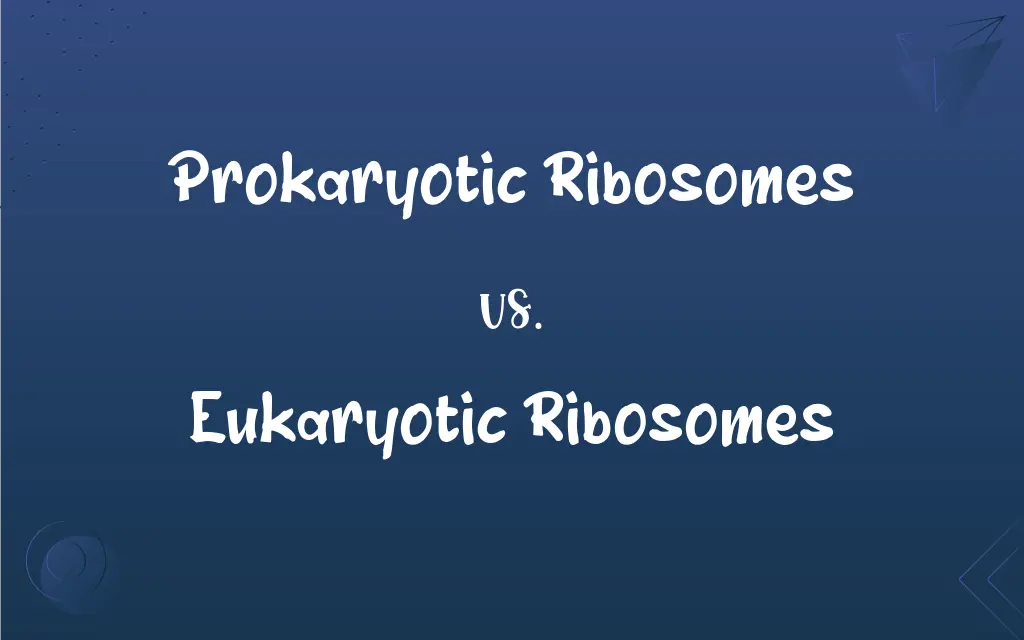Prokaryotic Ribosomes vs. Eukaryotic Ribosomes: What's the Difference?
Edited by Aimie Carlson || By Harlon Moss || Updated on October 30, 2023
Prokaryotic ribosomes are smaller (70S) than eukaryotic ribosomes (80S).

Key Differences
Prokaryotic ribosomes, found in bacteria and archaea, are smaller with a 70S sedimentation rate and are composed of 50S and 30S subunits. Eukaryotic ribosomes, found in animals, plants, fungi, and protists, are larger with an 80S sedimentation rate and are composed of 60S and 40S subunits.
Prokaryotic ribosomes are the site of protein synthesis in bacteria and archaea, and their structure is targeted by some antibiotics to prevent bacterial infections. Eukaryotic ribosomes, on the other hand, are found in the cytoplasm and on the endoplasmic reticulum and are the site of protein synthesis in eukaryotic cells.
Both prokaryotic and eukaryotic ribosomes are essential for the survival and function of the cell, as they play a critical role in the process of translation, where mRNA is decoded to produce proteins. However, the differences in their size and structure make them distinct entities.
In summary, while both prokaryotic and eukaryotic ribosomes serve the same fundamental purpose of protein synthesis, their differences in size, structure, and location reflect the distinct nature of prokaryotic and eukaryotic cells.
Comparison Chart
Size
Smaller (70S)
Larger (80S)
ADVERTISEMENT
Subunit Size
50S and 30S
60S and 40S
Location
Cytoplasm of bacteria and archaea
Cytoplasm and endoplasmic reticulum of eukaryotic cells
Sensitivity to Antibiotics
Sensitive
Not sensitive
Organisms
Bacteria and Archaea
Animals, plants, fungi, and protists
Prokaryotic Ribosomes and Eukaryotic Ribosomes Definitions
Prokaryotic Ribosomes
Prokaryotic ribosomes are sensitive to antibiotics.
Antibiotics can target the structure of prokaryotic ribosomes to prevent bacterial infections.
ADVERTISEMENT
Eukaryotic Ribosomes
Eukaryotic ribosomes are larger with an 80S sedimentation rate.
The larger size of eukaryotic ribosomes is a distinguishing factor from prokaryotic ribosomes.
Prokaryotic Ribosomes
Prokaryotic ribosomes are essential for the survival and function of bacteria and archaea.
Without prokaryotic ribosomes, bacteria and archaea would not be able to produce proteins.
Eukaryotic Ribosomes
Eukaryotic ribosomes are composed of 60S and 40S subunits.
The 60S and 40S subunits of eukaryotic ribosomes come together during translation.
Prokaryotic Ribosomes
Prokaryotic ribosomes are smaller with a 70S sedimentation rate.
The smaller size of prokaryotic ribosomes is a distinguishing factor from eukaryotic ribosomes.
Eukaryotic Ribosomes
Eukaryotic ribosomes are essential for the survival and function of eukaryotic cells.
Without eukaryotic ribosomes, eukaryotic cells would not be able to produce proteins.
Prokaryotic Ribosomes
Prokaryotic ribosomes are composed of 50S and 30S subunits.
The 50S and 30S subunits of prokaryotic ribosomes come together during translation.
Eukaryotic Ribosomes
Eukaryotic ribosomes are not sensitive to antibiotics.
The structure of eukaryotic ribosomes is different from prokaryotic ribosomes, making them not sensitive to antibiotics.
Prokaryotic Ribosomes
Prokaryotic ribosomes are the sites of protein synthesis in bacteria and archaea.
Prokaryotic ribosomes are targeted by antibiotics to treat bacterial infections.
Eukaryotic Ribosomes
Eukaryotic ribosomes are the sites of protein synthesis in eukaryotic cells.
Eukaryotic ribosomes are found in the cytoplasm and on the endoplasmic reticulum.
FAQs
What are eukaryotic ribosomes?
Eukaryotic ribosomes are larger ribosomes found in eukaryotic cells.
What is the sedimentation rate of prokaryotic ribosomes?
The sedimentation rate of prokaryotic ribosomes is 70S.
Are there any differences in the composition of prokaryotic and eukaryotic ribosomes?
Yes, prokaryotic ribosomes are composed of 50S and 30S subunits, while eukaryotic ribosomes are composed of 60S and 40S subunits.
Are prokaryotic ribosomes sensitive to antibiotics?
Yes, prokaryotic ribosomes are sensitive to antibiotics.
Are there any similarities between prokaryotic and eukaryotic ribosomes?
Yes, both prokaryotic and eukaryotic ribosomes are essential for protein synthesis.
What is the impact of antibiotics on prokaryotic ribosomes?
Antibiotics can target the structure of prokaryotic ribosomes to prevent bacterial infections.
Are there any structural differences between prokaryotic and eukaryotic ribosomes?
Yes, prokaryotic ribosomes are smaller and have different subunit sizes compared to eukaryotic ribosomes.
What is the sedimentation rate of eukaryotic ribosomes?
The sedimentation rate of eukaryotic ribosomes is 80S.
What are the subunits of prokaryotic ribosomes?
The subunits of prokaryotic ribosomes are 50S and 30S.
What are the subunits of eukaryotic ribosomes?
The subunits of eukaryotic ribosomes are 60S and 40S.
What is the function of ribosomes?
The function of ribosomes is to synthesize proteins.
What is the role of ribosomes in the process of translation?
Ribosomes are responsible for decoding mRNA to produce proteins during the process of translation.
What are prokaryotic ribosomes?
Prokaryotic ribosomes are smaller ribosomes found in bacteria and archaea.
Where are prokaryotic ribosomes found?
Prokaryotic ribosomes are found in the cytoplasm of bacteria and archaea.
Are eukaryotic ribosomes sensitive to antibiotics?
No, eukaryotic ribosomes are not sensitive to antibiotics.
What is the significance of the sedimentation rate of ribosomes?
The sedimentation rate indicates the size of the ribosomes, with larger ribosomes having a higher sedimentation rate.
How do ribosomes contribute to the survival of organisms?
Ribosomes are essential for the synthesis of proteins, which are necessary for the survival and function of organisms.
Where are eukaryotic ribosomes found?
Eukaryotic ribosomes are found in the cytoplasm and on the endoplasmic reticulum.
What organisms have prokaryotic ribosomes?
Bacteria and archaea have prokaryotic ribosomes.
What organisms have eukaryotic ribosomes?
Animals, plants, fungi, and protists have eukaryotic ribosomes.
About Author
Written by
Harlon MossHarlon is a seasoned quality moderator and accomplished content writer for Difference Wiki. An alumnus of the prestigious University of California, he earned his degree in Computer Science. Leveraging his academic background, Harlon brings a meticulous and informed perspective to his work, ensuring content accuracy and excellence.
Edited by
Aimie CarlsonAimie Carlson, holding a master's degree in English literature, is a fervent English language enthusiast. She lends her writing talents to Difference Wiki, a prominent website that specializes in comparisons, offering readers insightful analyses that both captivate and inform.
































































